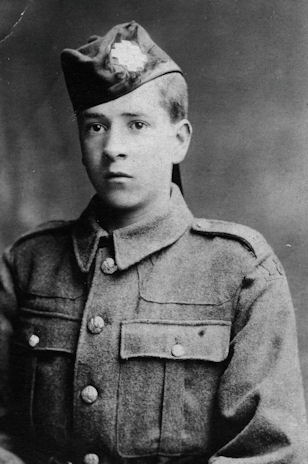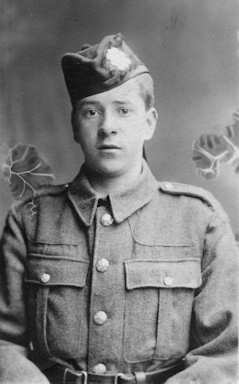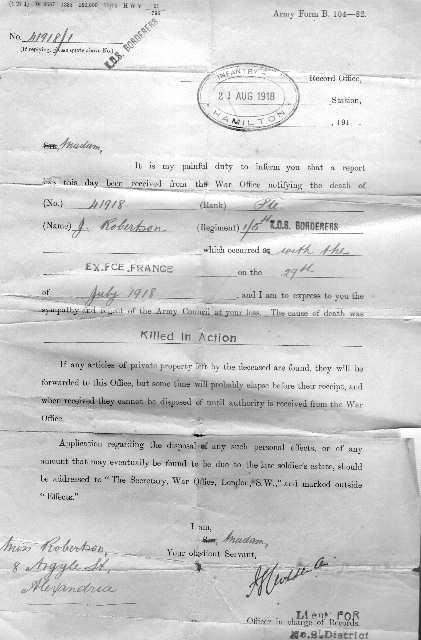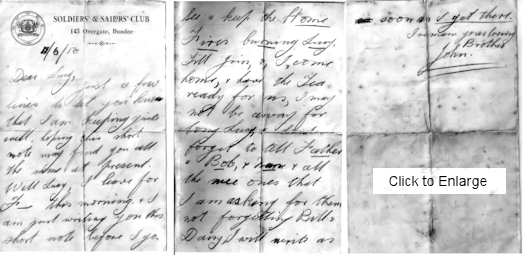John McDougall Robertson
 We are grateful to Jim and Sheila Biddulph for providing the web-site with the story of Sheila’s uncle, John McDougall Robertson, who was only 18 when he was killed in France in July 1918. Like so many of his comrades-in-arms he had his whole life ahead of him when he was killed in action, but also like so many others in the Vale and indeed across Europe he is remembered by his family who never had the opportunity to know him. And it is not a distant relationship – Sheila is John Robertson’s niece and in other circumstances would have expected to have known John for many years as she did his other brother who also served in the Army in WW1.
We are grateful to Jim and Sheila Biddulph for providing the web-site with the story of Sheila’s uncle, John McDougall Robertson, who was only 18 when he was killed in France in July 1918. Like so many of his comrades-in-arms he had his whole life ahead of him when he was killed in action, but also like so many others in the Vale and indeed across Europe he is remembered by his family who never had the opportunity to know him. And it is not a distant relationship – Sheila is John Robertson’s niece and in other circumstances would have expected to have known John for many years as she did his other brother who also served in the Army in WW1.
As well as his brief biography we also have an image of his last surviving letter which is quite upbeat and the telegram from the War Office notifying his sister Lucy that John had been Killed in Action. This is the only WW1 Casualty telegram which we have on the web-site and it makes bleak reading not just because of the message itself but because of the language in which it is couched.
Although John Robertson’s life was short it must have been pretty hectic. His father, William Robertson, was a gamekeeper and in those days gamekeepers worked on an annual contract and therefore tended to move about quite a bit. William Robertson and his wife had 10 children, some of whom were born in Milton of Campsie and some on the Stuckgown estate just south of Tarbet. John was the fourth child, being born in 1899; the Army records say he was born in Dumbarton but that could be a confusion with the fact that he enlisted in Dumbarton.
He probably started school in Milton of Campsie, but got most of his schooling at Tarbet School to which he and his siblings walked every school day, some in their bare feet. When he was only 14 years of age his mother died and it fell to his older sister Lucy to take care of all of her younger brothers and sisters, some of whom were still infants. It may have been for this reason that the father changed jobs again and the family moved to Argyll Street Alexandria after the mother’s death. Having left school by that time John got a job at the nearby Argyll Motor Works which from December 1914 was owned by the arms manufacturer Armstrong Whitworth and in which from early 1915 shells were being manufactured for the Royal Navy.
He was still too young to join the Army but one of his older brothers, Jim, joined up soon after the outbreak of war and he was serving in the King’s Own Scottish Borderers. You can imagine that to a youngster in difficult family circumstances his soldier brother would have seemed like a very appropriate role model, both as heroic figure and as a means of lessening the burden on his sister who was herself only a few years older than him. His letter shows his feelings for her and everyone else in the family especially “the little ones” and they were obviously a very close-knit family. However, he no doubt felt that he was lessening Lucy’s burden by joining up.
In January 1917 John enlisted in the Army at Dumbarton, enrolling first in the 5th Battalion Highland Light Infantry with the Serial Number 55012. He continued to serve in Scotland for another 18 months and sometime during that training period he transferred to the 5th Battalion King’s Own Scottish Borderers with the new Serial Number 41918. Such transfers between units were quite common in the British Army and it is noticeable with Scottish regiments that a favoured few east coast regiments were able to plunder west central units for replacements, the KOSB’s being one such favoured regiment. Although both brothers ended up in the KOSBs, that is probably coincidental rather than as a result of John asking for a transfer to his brother’s regiment.
On his last day in Scotland before travelling over to France and the front line, in fact the last day that he ever spent in Scotland, 12th June 1918, he sent a letter to his sister Lucy – a short note he called it – to tell her and the rest of the family that he was about to leave for France. This is the last surviving letter which the family have from John Robertson, although since he says in it that he will write as soon as he gets to France, there must have been others.
We can surmise a few things from the letter. It is written on the headed notepaper of the Soldiers & Sailors Club in Overgate, Dundee. There were many such Clubs in cities and towns throughout the UK and they provided a range of support services and facilities for members of the armed forces in WW1. The fact that he was writing from Dundee suggests that his unit had probably been at what is now Barry Buddon Camp at Carnoustie (in WW1 it was two separate camps) for final training in trench warfare. An extensive trench system, some of which can still be seen, was built there to familiarise troops about to leave for France with the sort of fighting which trench warfare entailed – although nothing could prepare them for the horrors they would have to endure in the actual front-line trenches.
The tone of the letter is very positive and the anxiety which he must have felt is well hidden. That is a characteristic of letters home in wartime – the soldiers almost always sought to convey a positive and confident message to their family even in the most appalling circumstances in the front line. Its other striking feature is the maturity of both style and content. One is tempted to think that not many of to-day’s 18 year olds could write such letters, but maybe they could after 4 years of warfare on the WW1 scale.
Shortly after finishing and posting that letter he would then have boarded a train in Dundee for the journey to a Channel port and the short crossing to a French port such as Boulogne or Calais, probably arriving in France by 14th or 15th June 1918.
 By the time of John Robertson’s arrival in France, the German Spring Offensive had already run out of steam. However since its start in March 1918 it had been extremely destructive of men and material on both sides and reinforcements / replacements were desperately needed everywhere on the front line. One major change was that the presence of American troops, now trained and ready for battle, had on paper at least, tilted the scales in the Allies favour. The French in particular were confident that they could push the Germans back in the centre of the Western Front and relieve any residual threat to Paris for once and for all. They were preparing a major attack for July 1918 which became known as the Marne-Aisne Offensive. A number of British units were detailed to fight under French command at the south-eastern extremity of the British front-line sector. The 15th (Scottish) Division was one of the British units chosen to fight in the French attack and 5th KOSB were part of the 15th Division.
By the time of John Robertson’s arrival in France, the German Spring Offensive had already run out of steam. However since its start in March 1918 it had been extremely destructive of men and material on both sides and reinforcements / replacements were desperately needed everywhere on the front line. One major change was that the presence of American troops, now trained and ready for battle, had on paper at least, tilted the scales in the Allies favour. The French in particular were confident that they could push the Germans back in the centre of the Western Front and relieve any residual threat to Paris for once and for all. They were preparing a major attack for July 1918 which became known as the Marne-Aisne Offensive. A number of British units were detailed to fight under French command at the south-eastern extremity of the British front-line sector. The 15th (Scottish) Division was one of the British units chosen to fight in the French attack and 5th KOSB were part of the 15th Division.
So as he landed in France, a longer journey to the front line awaited John Robertson and his fellow KOSB’s than they would have expected. It was doubly a journey into the unknown – going into battle for the first time and also fighting as part of a French army was not something that even his battle hardened comrades would have experienced. For an 18-year old youth it must have been a worrying time, probably frightened especially of not letting anyone down as much as of getting killed or wounded.
The Marne-Aisne Offensive started on 23rd July 1918 and it was a typically bloody affair. John Robertson was Killed in Action 6 days later on 29th July 1918. This was a little more than 6 weeks after he had written his last letter in Scotland to his sister Lucy and about 5 weeks after he arrived in the front line. By 1917-18 that was an all-too-typical experience for a young soldier.
John Roberson is now buried in Raperie British Cemetery at Villemontoire, but that Cemetery was not constructed until after the Armistice so he would have been buried in a battlefield grave when he was killed and re-interred in Raperie at a later date.
Although the CWGC records show John as having given his father William as his next of kin (with an address of 3 Argyll Street), John must have changed that arrangement at some stage from his father to his sister Lucy at the correct address of 8 Argyll Street.
As his letter shows it was Lucy to whom he wrote, so it made sense to have her as his next of kin. It was therefore to Lucy that the dreaded telegram was sent and it is still in Sheila and Jim’s possession.

The message in the telegram was shocking enough but what is striking to present-day readers is the starkness even brutality of the telegrams sent to next of kin of “other ranks”. Nothing in the telegram lessens the grief of the message; in fact it could almost have been designed to add to it; it is a particularly shabby document in almost every way.
- the way a soldier died is rubber stamped onto the telegram,
- next of kin have to apply for the return of private property and any pay which is due with no explanation of how to go about it
- no explanation is offered about the origins of the telegram – that it came from some office in Hamilton we only know because of a rubber date stamp
- the signature of the very junior officer who signed it is illegible,
- the pre-printed “sir” is crossed out and replaced by hand with “Madam”
- and no attempt is made to give any details of a soldier’s last days or final resting place.
As with everything else in the Army, even in death the officers were treated quite differently.
Finally of course there is the 4 week time-lag between John Robertson being killed on 29th July 1918 and the dispatch of the telegram from Hamilton on 21st August 1918 (Hamilton was in fact the depot for the KOSB’s during WW1, as well as being the long-time base of the Cameronians; the two units must have shared many functions in the Military Office, a building which stood in the middle of Hamilton until relatively recently). The absence of any communication was usually the first indication which a family had that something had happened to their loved one, and the wait for news was perhaps the greatest strain. All too often, as with John Robertson, the silence told the story of a young life cut short long before the young man had had a chance to live anything like a normal life leaving his family with their grieve and a gap for the rest of their lives.



